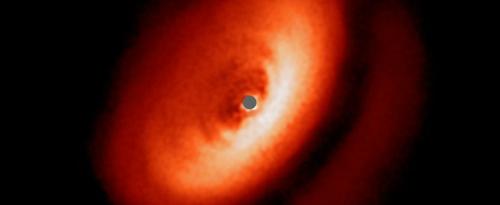SPHERE Reveals Fascinating Zoo of Discs Around Young Stars
The SPHERE instrument on ESO’s Very Large Telescope (VLT) in Chile allows astronomers to suppress the brilliant light of nearby stars in order to obtain a better view of the regions surrounding them. This collection of new SPHERE images is just a sample of the wide variety of dusty discs being found around young stars.

New images from the SPHERE instrument on ESO’s Very Large Telescope are revealing the dusty discs surrounding nearby young stars in greater detail than previously achieved. They show a bizarre variety of shapes, sizes and structures, including the likely effects of planets still in the process of forming.
These discs are wildly different in size and shape — some contain bright rings, some dark rings, and some even resemble hamburgers. They also differ dramatically in appearance depending on their orientation in the sky — from circular face-on discs to narrow discs seen almost edge-on.
SPHERE’s primary task is to discover and study giant exoplanets orbiting nearby stars using direct imaging. But the instrument is also one of the best tools in existence to obtain images of the discs around young stars — regions where planets may be forming. Studying such discs is critical to investigating the link between disc properties and the formation and presence of planets.
Many of the young stars shown here come from a new study of T Tauri stars, a class of stars that are very young (less than 10 million years old) and vary in brightness. The discs around these stars contain gas, dust, and planetesimals — the building blocks of planets and the progenitors of planetary systems.
These images also show what our own Solar System may have looked like in the early stages of its formation, more than four billion years ago.
Most of the images presented were obtained as part of the DARTTS-S (Discs ARound T Tauri Stars with SPHERE) survey. The distances of the targets ranged from 230 to 550 light-years away from Earth. For comparison, the Milky Way is roughly 100 000 light-years across, so these stars are, relatively speaking, very close to Earth. But even at this distance, it is very challenging to obtain good images of the faint reflected light from discs, since they are outshone by the dazzling light of their parent stars.
Another new SPHERE observation is the discovery of an edge-on disc around the star GSC 07396-00759, found by the SHINE (SpHere INfrared survey for Exoplanets) survey. This red star is a member of a multiple star system also included in the DARTTS-S sample but, oddly, this new disc appears to be more evolved than the gas-rich disc around the T Tauri star in the same system, although they are the same age. This puzzling difference in the evolutionary timescales of discs around two stars of the same age is another reason why astronomers are keen to find out more about discs and their characteristics.
Astronomers have used SPHERE to obtain many other impressive images, as well as for other studies including the interaction of a planet with a disc, the orbital motions within a system, and the time evolution of a disc.
The new results from SPHERE, along with data from other telescopes such as ALMA, are revolutionising astronomers’ understanding of the environments around young stars and the complex mechanisms of planetary formation.
Source: European Southern Observatory
- 352 reads
Human Rights
Ringing FOWPAL’s Peace Bell for the World:Nobel Peace Prize Laureates’ Visions and Actions

Protecting the World’s Cultural Diversity for a Sustainable Future

The Peace Bell Resonates at the 27th Eurasian Economic Summit

Declaration of World Day of the Power of Hope Endorsed by People in 158 Nations

Puppet Show I International Friendship Day 2020

